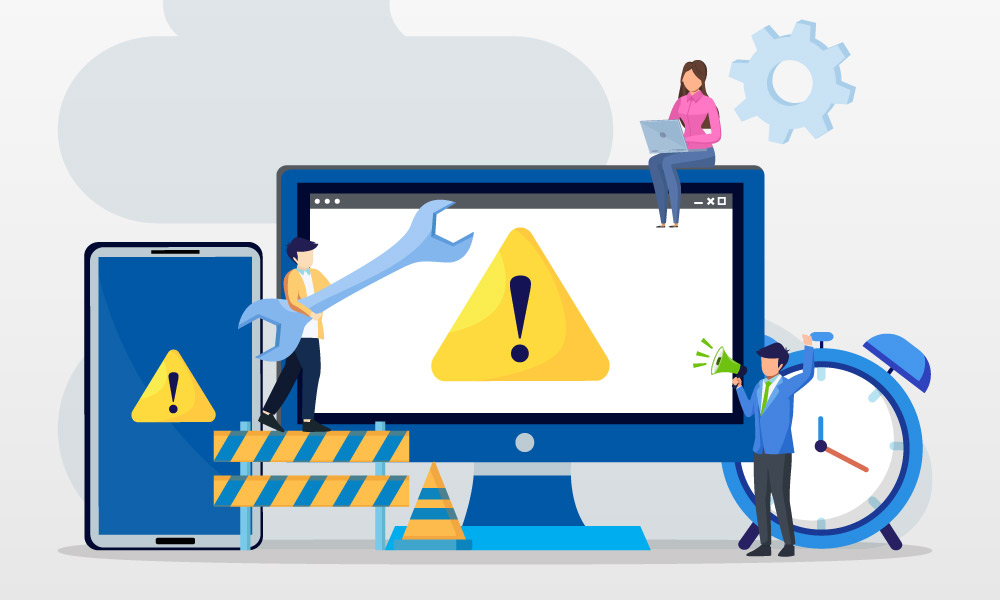A Complete Guide to Designing a B2B Website from Scratch

When designing a B2B website, you’re creating more than a digital space—you’re shaping a first impression that speaks before a word is read.
In today’s online-driven world, a well-designed site does more than look good; it fuels business growth by building trust and driving engagement.
An intelligent blend of innovation and simplicity in website development can turn curiosity into connection, setting your brand apart in a competitive market.
Key Takeaways:
How Do I Create a Good B2B Website?
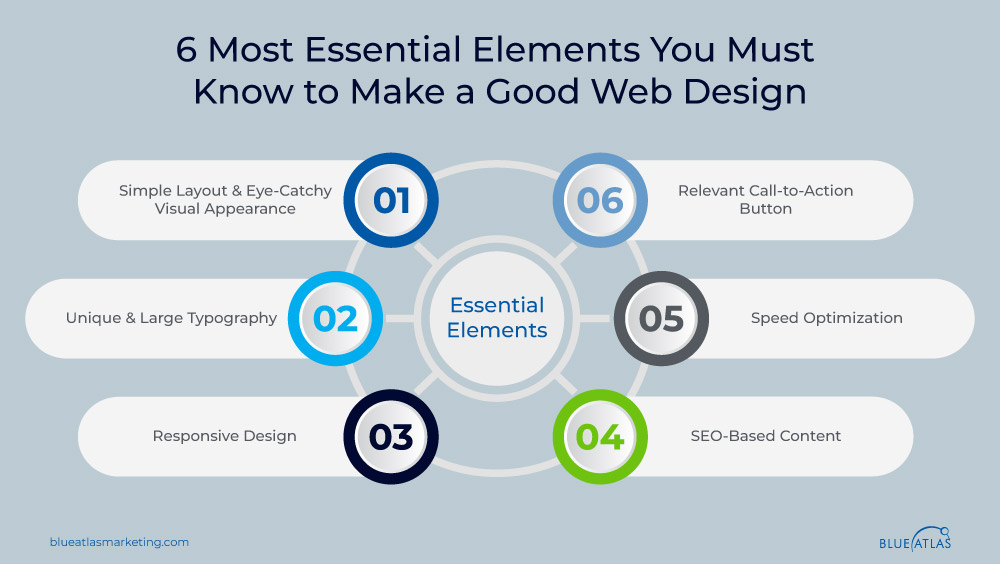
Building a B2B website that stands out means combining aesthetics with function and simplicity with sophistication.
Let’s break down the essential elements that ensure your website drives results.
First, start with a simple layout and eye-catching visuals. Less clutter means more focus on what truly matters—your message.
Next, integrate unique and large typography to make your content stand out and guide visitors’ attention naturally.
Don’t forget responsive design—your site should look and perform flawlessly on all devices.
SEO-based content is another non-negotiable. Your website’s words should be crafted for human readers and search engines.
Also, speed matters. Optimize your site’s load time to keep visitors engaged.
Finally, make your calls-to-action (CTAs) clear and relevant so potential clients know exactly what to do next.
Understanding Differences Between B2C and B2B Web Design Practices
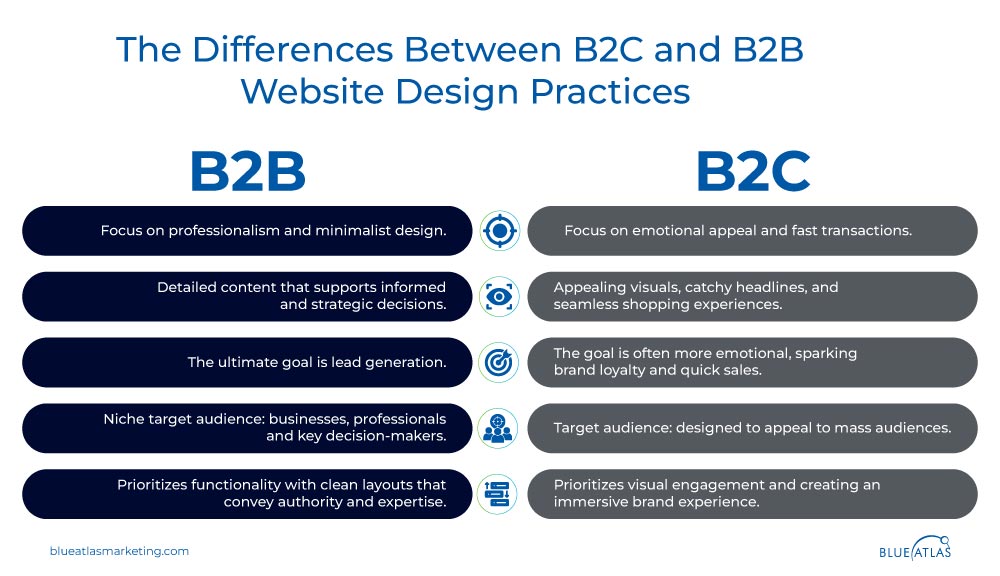
Designing for B2B and B2C websites isn’t a one-size-fits-all approach. The differences are subtly tangible; recognizing them is key to crafting a site that works for your audience.
B2B websites focus on professionalism and a minimalist design. Decision-makers in the B2B space want detailed content that supports informed, strategic decisions.
The ultimate goal is lead generation, nurturing long-term business relationships through trust-building and conversion. The target audience here is more niche: businesses, professionals, and key decision-makers.
Therefore, the design must prioritize functionality, with clean layouts that convey authority and expertise.
On the other hand, B2C websites are designed to appeal to mass audiences. The emphasis is on visual engagement and creating an immersive brand experience.
The goal is often more emotional—sparking brand loyalty and quick sales through appealing visuals, catchy headlines, and seamless shopping experiences.
To summarize, while B2B designs focus on precision and fostering business relationships, B2C designs lean on emotional appeal and fast transactions.
Steps to Building a High-Quality B2B Website
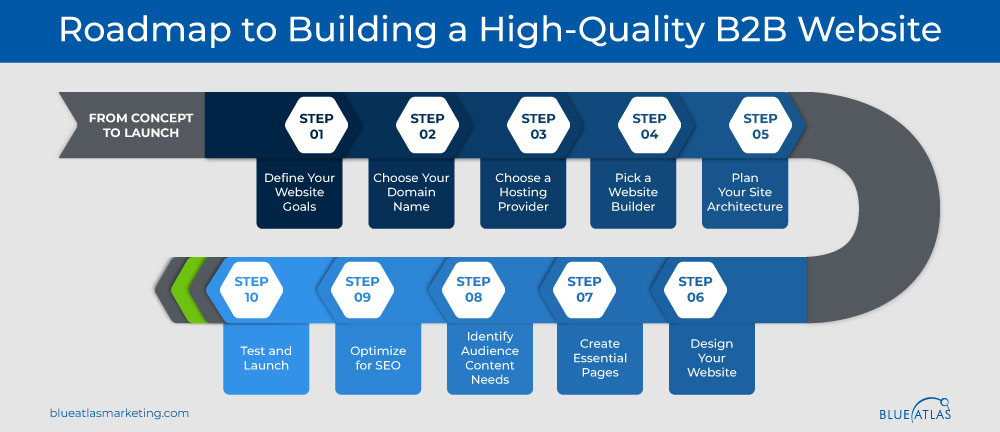
Designing a website from scratch requires a strategic, step-by-step approach.
Here’s a clear roadmap to get you from concept to launch:
- Define Your Website Goal – whether it’s generating leads or showcasing services, your site needs a clear objective. For instance, a B2B SaaS company may prioritize sign-ups for demos as their primary goal.
- Choose Your Domain Name – select a domain name that reflects your brand and is easy to remember. Famous domains are Facebook, Google, YouTube, etc.
- Choose a Hosting Provider – if you’re self-hosting, find a provider that offers fast, reliable service. Like a manufacturing site, B2B websites with large catalogs need hosting that handles high traffic and secure transactions.
- Pick a Website Builder – choose a platform that fits your needs. For example, a marketing agency might opt for WordPress for its flexibility and plugins.
- Plan Your Site Architecture – organize your pages logically. A consulting firm might structure its site around services, case studies, and a blog for thought leadership.
- Design Your Website – create a professional, clean design that supports your business goals. Minimalist layouts work well for financial services companies looking to build trust.
- Create Essential Pages – key pages like About Us, Services, and Contact should be easy to find. B2B buyers rely on these to make decisions.
- Identify Audience Content Needs – tailor your content to address common business interests. For example, a tech solutions provider might focus on content addressing scalability and security.
- Optimize for SEO – incorporate keywords and meta descriptions to boost visibility. For a logistics company, this could mean optimizing for terms like “supply chain management solutions.”
- Test and Launch – conduct thorough testing before launch to ensure everything works smoothly, from mobile responsiveness to form submissions.
Key Elements of a Successful B2B Website Design

Creating a successful B2B website means focusing on several key components that ensure functionality, innovation, and market reach.
Exploring digital B2B sales channels
- Modern B2B websites need to go beyond a simple brochure site.
- Consider your site a digital storefront where clients can easily navigate products or services.
- For instance, integrating e-commerce functionalities can allow seamless online transactions.
Defining the key priorities for your platform
- Identify what matters most for your business.
- Is it lead generation, client retention, or product showcasing?
- A SaaS company may prioritize client engagement through interactive demos and webinars.
Streamlining order processing and customer service
- Your website should make completing transactions easy and offer customer support.
- Automated billing systems or live chat features can reduce the need for human intervention.
Eliminating reliance on sales representatives
- A successful B2B website allows customers to gather information independently without always relying on sales teams.
- Self-service tools and comprehensive product documentation can help.
Expanding beyond traditional markets
- Your website can tap into new global markets.
- Optimizing for international SEO and offering multiple languages are effective strategies for going beyond local boundaries.
Using data to redefine marketing strategy
- Leverage analytics to understand your users’ behaviors and adapt your marketing efforts accordingly.
Innovating through your digital platform
- Consider your site a testing ground for new ideas, whether related to content formats, interactive elements, or customer engagement tools.
10 Best-in-Class B2B Websites
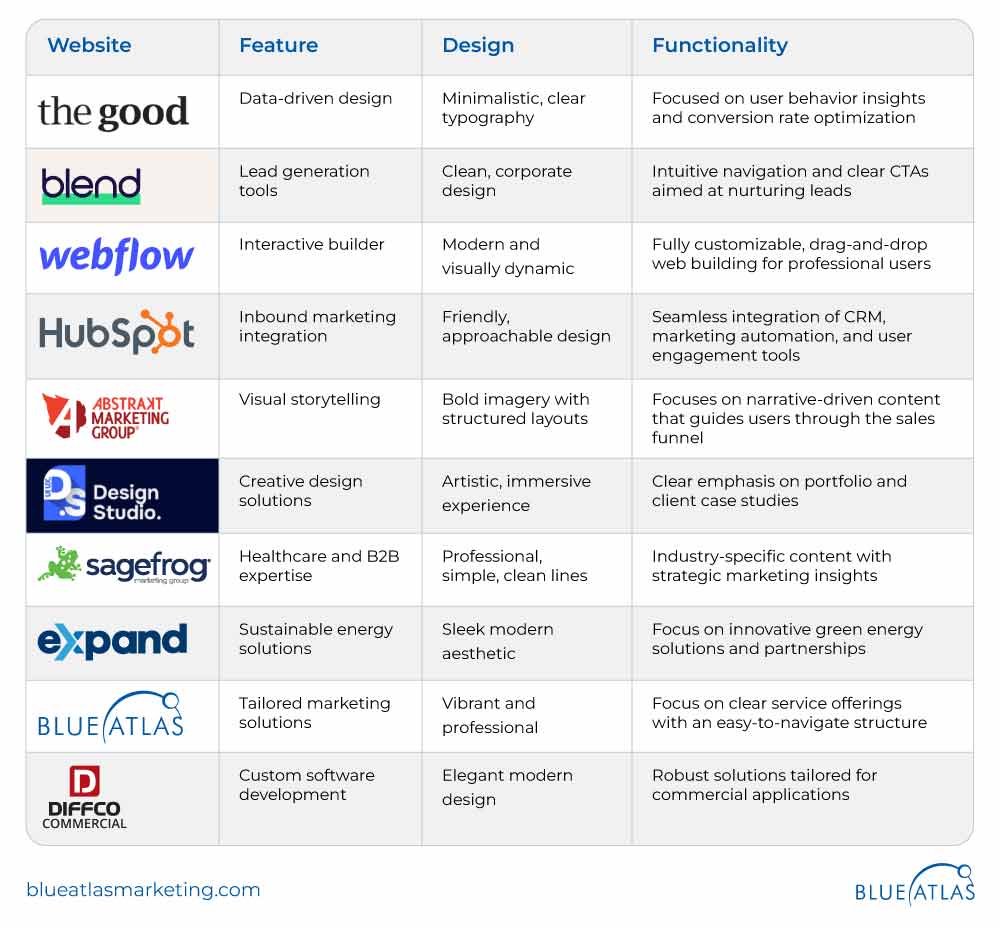
The following websites stand out in B2B design for their innovation, aesthetic appeal, and seamless functionality.
Here’s a look at what makes each of these examples effective and influential:
| Website | Feature | Design | Functionality |
| TheGood | Data-driven design | Minimalist, clear typography | Focused on user behavior insights and conversion rate optimization |
| BlendB2B | Lead generation tools | Clean, corporate design | Intuitive navigation and clear CTAs aimed at nurturing leads |
| WebFlow | Interactive builder | Modern and visually dynamic | Fully customizable, drag-and-drop web building for professional users |
| HubSpot | Inbound marketing integration | Friendly, approachable design | Seamless integration of CRM, marketing automation, and user engagement tools |
| Abstraktmg | Visual storytelling | Bold imagery with structured layouts | Focuses on narrative-driven content that guides users through the sales funnel |
| DesignStudio | Creative design solutions | Artistic, immersive experience | Clear emphasis on portfolio and client case studies |
| SageFrog | Healthcare and B2B expertise | Professional, simple, clean lines | Industry-specific content with strategic marketing insights |
| Expand Energy | Sustainable energy solutions | Sleek modern aesthetic | Focus on innovative green energy solutions and partnerships |
| Blue Atlas Marketing | Tailored marketing solutions | Vibrant and professional | Focus on clear service offerings with an easy-to-navigate structure |
| Diffco Commercial | Custom software development | Elegant modern design | Robust solutions tailored for commercial applications |
Advanced B2B Web Design Practices
Advanced strategies go beyond aesthetics to create a website that engages users and drives conversions.
These practices are focused on improving user interaction, building relationships, and boosting overall effectiveness.
First, consider deepening visitor engagement with an opt-in form.
Offering valuable content in exchange for an email keeps users connected to your brand.
This simple yet effective strategy can turn casual visitors into long-term leads.
Next, provide customization options. Personalizing the user experience, such as tailored content or product recommendations, creates a more meaningful interaction.
It makes your website feel more relevant to individual users, increasing their likelihood to convert.
Social media integration is another powerful tool. Linking your website to platforms like LinkedIn or Twitter extends your reach and creates a seamless user journey.
Sharing relevant content directly from your site can amplify your brand’s voice.
Moreover, starting a conversation is key, so use live chat or messaging tools to connect with your visitors in real-time.
This personal touch helps users get answers immediately, fostering trust. It also shortens the decision-making process.
Lastly, utilize product videos to showcase your offerings in an engaging way.
Videos are an excellent method for explaining complex services or products in a simple format.
They also keep users on your site longer, improving SEO and conversion rates.
Optimizing B2B Website for Lead Generation and Conversion
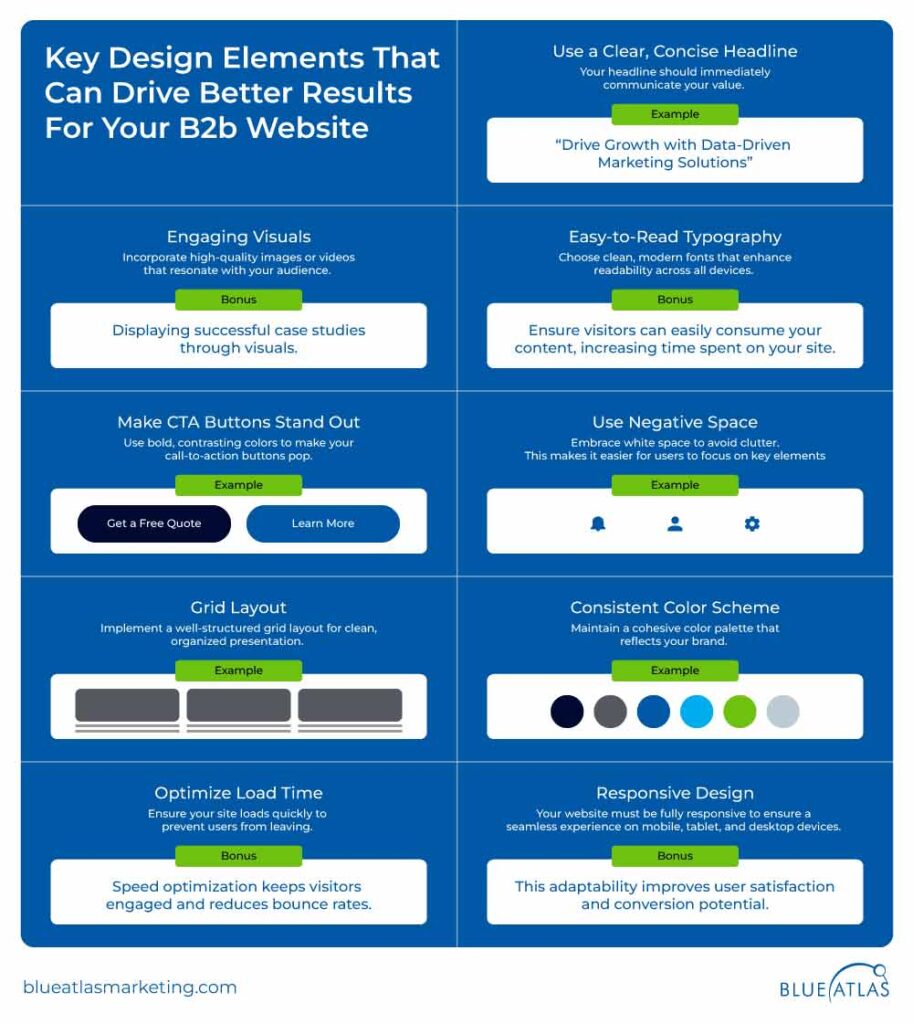
Improving lead generation and conversion rates through thoughtful website design requires a strategic approach.
Several key design elements can drive better results for your B2B website:
Measuring the Success and Performance
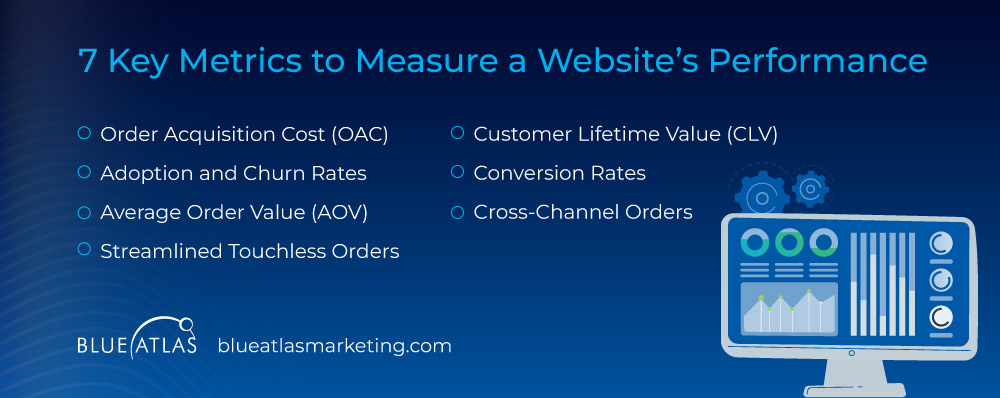
Tracking KPIs and metrics that reflect performance and profitability is essential to ensuring your B2B website delivers the desired results.
Here are the key metrics you should monitor to measure success effectively:
The Role of Content in Website Design
Content is the backbone of a website, shaping user experience and directly influencing the effectiveness of your design.
A strong content strategy aligns your business goals with audience needs, creating a meaningful visitor experience.
First, begin with well-outlined goals and limitations. Knowing what you want to achieve—whether it’s generating leads, educating customers, or showcasing expertise—helps guide your content decisions and keeps efforts focused.
Next, define your audience persona. Understanding your target audience’s interests, preferences, and needs ensures your content speaks directly to them.
A well-developed persona allows you to create content that resonates on a deeper level.
Perform a content audit and analysis to identify gaps and opportunities.
By reviewing your existing content, you can determine what’s working and needs improvement.
This step ensures consistency and relevance across all content types.
Speaking of types, choose the proper content formats and channels.
Blog posts, case studies, white papers, or videos should fit your audience’s preferences and the goals of each stage in the buyer’s journey.
Ensure a smooth content creation process by establishing workflows for topic selection, writing, and publishing.
This will keep your strategy on track and deadlines manageable.
Lastly, focus on measurement and analytics. Tracking the performance of your content through KPIs like engagement rates and conversions helps refine your strategy over time.
Emerging Trends and Technologies in Website Design
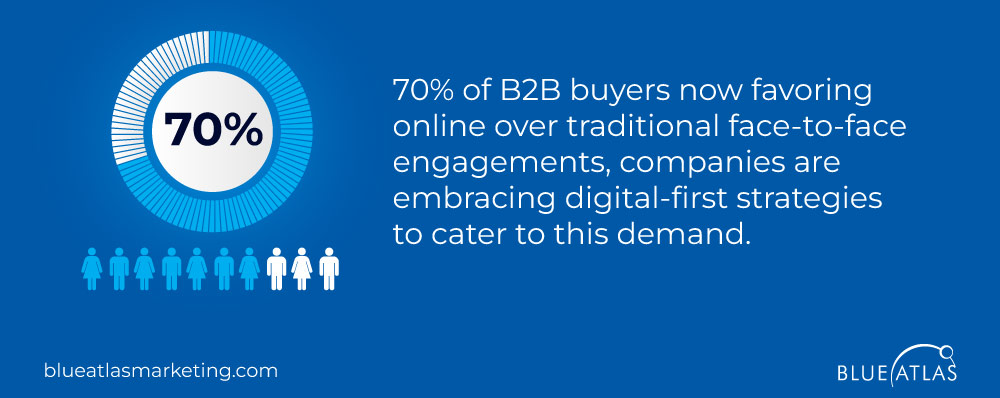
The rapid evolution of digital channels is reshaping how B2B businesses interact with clients.
One major shift is the increasing preference for digital and remote interactions.
With 70% of B2B buyers now favoring online over traditional face-to-face engagements, companies are embracing digital-first strategies to cater to this demand.
Websites need to support this shift with seamless, intuitive user experiences.
Artificial intelligence (AI) and machine learning also play a growing role in enhancing personalization.
AI-driven tools can tailor content, product recommendations, and even customer service interactions to individual users, making each experience more relevant.
Another trend is the rise of interactive content, such as product configurators or virtual tours.
These tools allow potential buyers to engage deeply with products and services, improving user experience and decision-making.
Finally, automation technologies are streamlining processes, from lead generation to order fulfillment, helping businesses handle increasing digital demand without sacrificing efficiency.
Frequently Asked Questions (FAQs)
What are the key differences between B2B and B2C website design?
B2B websites prioritize a professional and minimalistic design, focusing on informative content that conveys the value proposition and addresses buyer personas throughout longer sales cycles. In contrast, B2C sites emphasize engaging visual elements to facilitate quick purchases from mobile devices.
How can I effectively target my audience when designing a B2B website?
To effectively target your audience, research their needs and pain points. Tailor your design, informative content, and overall customer experience to resonate with your buyer personas, ensuring the website supports their decision-making process and enhances engagement.
What is the best way to integrate SEO into website design?
Incorporating SEO involves optimizing various elements such as content, meta descriptions, and keywords. Focus on creating high-quality, informative content that aligns with user intent to improve rankings and attract organic traffic, ultimately enhancing the website’s overall visibility.
How often should I update my website to keep it relevant?
To maintain relevance, update your B2B website’s content, technology, and visual elements at least every 2-3 years. Regular updates help ensure the site aligns with evolving customer needs and industry trends, keeping your brand competitive.
Designing a B2B website is a powerful step toward boosting brand awareness and elevating your online presence. With the right web design, search engine optimization, and a focus on user experience, your site can generate valuable leads and deliver the best results for your business.
Ready to create a website that stands out? Let’s build a platform that drives growth and lasting connections.
Why Blue Atlas Marketing?
Our team members excel in careful planning and crafting effective B2B websites that blend stunning design with top-notch website performance.
Whether you’re looking for a complete website redesign or strategic updates, we’re ready to help you create a site that aligns perfectly with your business goals.
Reach out to Blue Atlas Marketing today, and let’s embark on a transformation of your website!

